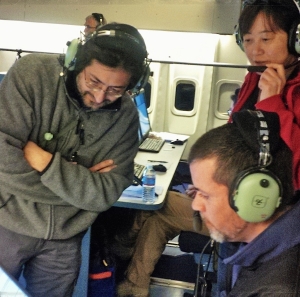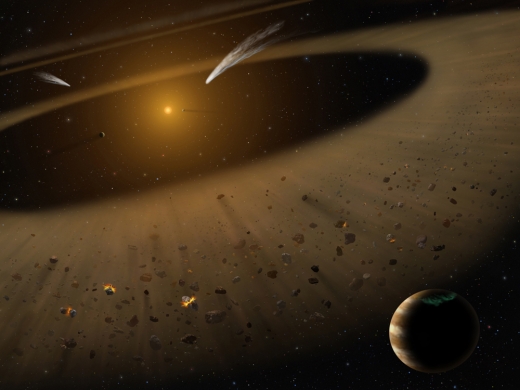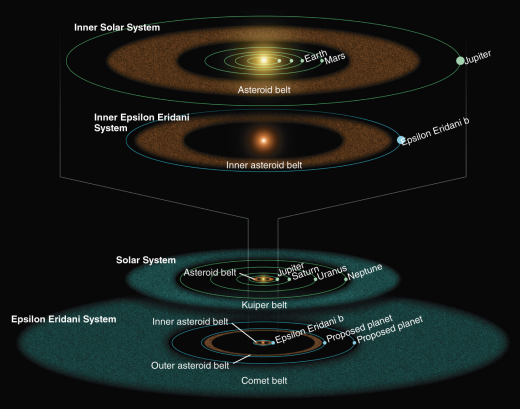
Nine years ago in a piece titled Asteroid Belts, Possible Planets Around Epsilon Eridani, I discussed work that Massimo Marengo was doing on the nearby star, examining rings of material around Epsilon Eridani and considering the possibilities with regard to planets. Marengo (now at Iowa State University) has recently been working with Kate Su (University of Arizona) and other colleagues, using the SOFIA telescope (Stratospheric Observatory for Infrared Astronomy) to help us refine our understanding of the evolving planetary system.
Image: Astronomers (left to right) Massimo Marengo, Andrew Helton and Kate Su study images of epsilon Eridani during their SOFIA mission. Credit: Massimo Marengo.
The researchers used the 2.5-meter telescope aboard the Boeing 747SP jetliner to collect data about the star, working at 45,000 feet in a region above most of the atmospheric water vapor that absorbs the infrared light being studied. Epsilon Eridani is a bit over 10 light years from the Sun, and about a fifth of its age, meaning we have close at hand a stellar system that can help us understand what our own Solar System was like in its youth.
The new paper confirms Marengo’s earlier findings that there are separate inner and outer disk structures, with the possibility that the inner disk is itself made up of more than one debris belt. Says Marengo:
“This star hosts a planetary system currently undergoing the same cataclysmic processes that happened to the solar system in its youth, at the time in which the moon gained most of its craters, Earth acquired the water in its oceans, and the conditions favorable for life on our planet were set.”

Image: This is an artist’s illustration of the Epsilon Eridani system showing Epsilon Eridani b, right foreground, a Jupiter-mass planet orbiting its parent star at the outside edge of an asteroid belt. In the background can be seen another narrow asteroid or comet belt plus an outermost belt similar in size to our Solar System’s Kuiper Belt. The similarity of the structure of the Epsilon Eridani system to our Solar System is remarkable, although Epsilon Eridani is much younger than our sun. SOFIA observations confirmed the existence of the asteroid belt adjacent to the orbit of the Jovian planet. Credit: NASA/SOFIA/Lynette Cook.
This is fine-grained work, for it requires the astronomers to separate the faint emission of Epsilon Eridani’s circumstellar disk from the bright light of the host star. But when Marengo likens the work with SOFIA to using a time machine, he has an obvious point. Debris disks result when belts of planetesimals are perturbed by newly formed planets, creating collisions that over time break the minor bodies down into dust. We know of more than 400 debris disks around other stars, but we have few systems close enough to study at high resolution. Moreover, what the paper describes as the two benchmark nearby debris disks are around A-class stars, Fomalhaut and Vega. Epsilon Eridani gives us a star much more like the Sun.
Debris disks, which can include rocky and icy bodies as well as gas and dust, can be broad, continuous disks or they can become concentrated into belts of debris. Here the analogy is to our own Solar System’s asteroid belt and Kuiper Belt, two distinct regions with one disk of debris concentrated beyond the orbit of Mars and the other beyond the orbit of Neptune. With an outer cold disk and a warm inner one assumed, the new work focuses on the inner disk. Here there are two different models for how the inner disk is formed, with implications for planets.
One model calls for an inner disk made up of two narrow rings of debris, with one ring roughly at the position of our asteroid belt around the star, and the other at a region corresponding to the orbit of Uranus. The other model sees the inner disk region being populated by dust from the outer, Kuiper Belt-like region, with material inflowing into the inner disk. The latter model assumes a single broad disk in the inner system as opposed to two belt-like rings. The new SOFIA observations favor the narrow belt model rather than a broad continuous disk.
Combining data from SOFIA with earlier Spitzer observations, the researchers found that excess emissions in the inner 25 AU region around the star are the result of a dust-producing planetesimal belt, and perhaps more than one. For it turns out that the resolution achieved by the SOFIA data was insufficient to determine whether the inner disk is itself divided into more than one narrow belts, but it did allow the team to rule out the possibility that the inner region’s warm emissions were the result of dust grains pulled in from an outer, much colder belt.
That favors the first model. The paper makes the case that in the absence of dust grains being dragged in from the cold outer belt, a planet might be necessary to explain what is seen in Epsilon Eridani’s inner disk structure. From the paper:
The observed profiles are not consistent with the case dominated by dragged-in grains (uninterrupted dust flow from the cold Kuiper-belt-analog region) as proposed by Reidemeister et al. (2011). This might suggest the need of a planet interior to the 64-au cold belt to maintain the inner dust-free zone, or a very dense cold belt where the intense collisions destroy the dust grains before they have enough time to be dragged in. In either case, some amount of dragged-in grains from the cold belt can still contribute a fraction of the emission inside 25 au; the exact amount remains to be determined by future high spatial resolution.

Image: Illustration based on Spitzer observations of the inner and outer parts of the Epsilon Eridani system compared with the corresponding components of our Solar System. Credit: NASA/JPL/Caltech/R. Hurt (SSC).
What we do have, though, is confirmation that we have at least one inner disk, and that it is near the orbit of the Jupiter-class planet that circles the star at a distance comparable to Jupiter’s from the Sun. Kate Su explains:
“The high spatial resolution of SOFIA combined with the unique wavelength coverage and impressive dynamic range of the FORCAST camera allowed us to resolve the warm emission around eps Eri, confirming the model that located the warm material near the Jovian planet’s orbit. Furthermore, a planetary mass object is needed to stop the sheet of dust from the outer zone, similar to Neptune’s role in our solar system. It really is impressive how eps Eri, a much younger version of our solar system, is put together like ours.”
The paper is Su et al., “The Inner 25 AU Debris Distribution in the epsilon Eri System,” Astronomical Journal Vol. 153, No. 5 (25 April 2017). Abstract / preprint.



Debris disks result when belts of planetesimals are perturbed by newly formed planets, creating collisions that over time break the minor bodies down into dust.
If planetesimals break down into dust when they collide, then how do they accrete into planets?
Does this CD article help?
‘Dust Traps’ and Planet Formation
Well, debris disks are also a kind of left-overs, after the planets have formed, usually having too little mass to accrete into another planet. Our asteroid belt for instance, has a mass of only about 4% of that of our moon. And that little amount is also perturbed by the *already existing* planets.
What would be the difference in infrared from an asteroid belt and a large Ringworld? Epsilon Eridani is a young system so it is probable that it’s debris disk, but Tau Ceti is much older and the debris area is much further out. How many of these 400 stars with rings of debris are around older systems? How many have shown up in the Kepler data – how can we tell the difference between natural structures and Ringworlds or groups of Dyson spheres?
Dyson sphere look alikes:
http://home.fnal.gov/~carrigan/infrared_astronomy/Dyson_sphere_look_alikes.htm
HUNTING FOR ALIEN MEGASTRUCTURES:
https://www.universetoday.com/102348/hunting-for-alien-megastructures/
Building the ultimate Solar System:
https://planetplanet.net/2014/05/13/building-the-ultimate-solar-system/
The Ultimate Engineered Solar System:
https://planetplanet.net/2017/05/03/the-ultimate-engineered-solar-system/
We can’t. There are actually several Dyson Sphere candidates, but we can’t confirm if these are natural or artificial objects.
How about alien Starshades…
https://arxiv.org/abs/1705.01285
Transit Detection of a “Starshade” at the Inner Lagrange Point of an Exoplanet
Eric Gaidos
(Submitted on 3 May 2017)
All water-covered rocky planets in the inner habitable zones of solar-type stars will inevitably experience a catastrophic runaway climate due to increasing stellar luminosity and limits to outgoing infrared radiation from wet greenhouse atmospheres.
Reflectors or scatterers placed near Earth’s inner Lagrange point (L1) have been proposed as a ‘geo-engineering” solution to anthropogenic climate change and an advanced version of this could modulate incident irradiation over many Gyr or “rescue” a planet from the interior of the habitable zone.
The distance of the starshade from the planet that minimizes its mass is 1.6 times the Earth-L1 distance. Such a starshade would have to be similar in size to the planet and the mutual occultations during planetary transits could produce a characteristic maximum at mid-transit in the light-curve.
Because of a fortuitous ratio of densities, Earth-size planets around G dwarf stars present the best opportunity to detect such an artifact. The signal would be persistent and is potentially detectable by a future space photometry mission to characterize transiting planets. The signal could be distinguished from natural phenomenon, i.e. starspots or cometary dust clouds, by its shape, persistence, and transmission spectrum.
Comments: MNRAS, in press
Subjects: Earth and Planetary Astrophysics (astro-ph.EP)
Cite as: arXiv:1705.01285 [astro-ph.EP]
(or arXiv:1705.01285v1 [astro-ph.EP] for this version)
Submission history
From: Eric Gaidos [view email]
[v1] Wed, 3 May 2017 07:41:17 GMT (318kb)
https://arxiv.org/pdf/1705.01285.pdf
Out of the box thinking never hurts, especially when it comes to SETI, where it is long overdue.
It may be hard to spot as the best way to have a star shade is not to reflect the light or absorb it for re-emission but to bend the light slightly to miss the planet which would minimise any forces on it.
Ringworlds require materials with impossible mechanical properties. This leads to an easy way to determine whether a signal represents a ringworld: if it’s from this universe, it isn’t a ringworld.
Remember, just because a science fiction writer (even a famous science fiction writer) used an idea, it doesn’t make it physically possible.
The same might be said of Dyson spheres, but that doesn’t rule out Dyson swarms or “ring” swarms. If we could find a way to detect the difference between an asteroid belt and a belt containing manufactured habitats, that would be useful.
Not to mention the mini-Dyson torus sphere…err not sure that has be discussed at length before. If you have many, many torus’s having 1 g in their rotations they can all be connected via a flexible tube complex so having a truly huge habitatable area and at 1 g to boot.
Sean Raymond link from his comment on :https://planetplanet.net/2017/05/03/the-ultimate-engineered-solar-system/
http://www.alcyone.com/max/writing/essays/why-niven-rings-are-unstable.html
Rings are OUT!
What could an advanced civilization develop that could be observed in transit as an artificial structures and still be stable? Multiple moons around an earth like exoplanet, what could we do in the next 1000 years that could be used to make real estate for an exploding population? Turn our moon inside out to make the ultimate condominium, so a large exomoon with very low density, what about doing this to Mars? Since a round planet is the most stable natural form, should we be looking for low density exoplanets? What would the best form be to give the population a descent view instead of the being stuck in the bottom? How could a magnetic field and atmosphere/shielding be developed to protect them from radiation and micrometeorites? Saturn is low density plus has rings but the size would indicate a large hydrogen/ helium atmosphere. Superearth with extreme low density would seem to be a likely candidate or maybe some of the waterworlds around Trappist 1, just make sure natural rings are not giving false readings on the diameter.
“Tau Ceti is much older and the debris area is much further out. How many of these 400 stars with rings of debris are around older systems”.
In fact quite a few: of nearby solar-type stars alone, I know of, besides Tau Ceti, also 82 Eridani, 61 Virginis and probably also Alpha Mensae, having debris disks beyond 10 AU. All these stars are rather old, > 5 gy.
It’s still not clear that the planet candidate ? Eridani b actually exists. Anglada-Escudé et al. (2012) do not recover the original orbit solution, and Zechmeister et al. (2013) do not find it at all. The astrometric detection depends on the RV orbit as the full orbital period was not covered, so does not constitute an independent detection of the planet. Furthermore the previously-claimed alignment of the planet and the disc does not seem to hold up: today’s arXiv has a paper about the observation of the ? Eridani disc with ALMA in which it is noted that the claimed longitude of the ascending node for the planet differs by about 30° from that of the disc.
The Northern Arc of ? Eridani’s Debris Ring as Seen by
ALMA.
ABSTRACT
“We present the first ALMA observations of the closest known extrasolar debris disc. This disc orbits the star Eri, a K-type star just 3.2 pc away. Due to the proximity of the star, the entire disc cannot fit within the ALMA field of view. Therefore, the observations have been centred 1800 North of the star, providing us with a clear detection of the northern arc of the ring, at a wavelength of 1.3 mm. The observed disc emission is found to be narrow with a width of just 11-13 AU. The fractional disc width we find is comparable to that of the Solar System’s Kuiper Belt and makes this one of the narrowest debris discs known. If the inner and outer edges are due to resonances
with a planet then this planet likely has a semi-major axis of 48 AU. We find tentative evidence for clumps in the ring, although there is a strong chance that at least one is a background galaxy. We confirm, at much higher significance, the previous detection of an unresolved emission at the star that is above the level of the photosphere and attribute this excess to stellar chromospheric emission.”
https://arxiv.org/pdf/1705.01560.pdf
WATER, WATER, EVERYWHERE!!! Water Maser(22ghz-1.35cm)microwave emission detected at Epsilon Eridani(from either disks OR planets)AND at BOTH Lalande 21185(10Me planet candidate)and Gliese 581(1.9Me, 5.5Me, and 25Me CONFIRMED planets and a host of UNCONFIRMED ones). Could be from either lightning in water clouds OR from the surface of liquid oceans!!! International Journal of Astrobiology: “Water Maser emission from exoplanetary systems”. by C. B. Cosmovici and S Pogrebenko.
EVEN MORE WATER!!! Water in the atmosphere of 55 Cancri E CONFIRMED(atmospheric scale height of 80KM)” Search for water in a Super Earth atmosphere. High resolution optical spectroscopy of 55 Cancri e”. by Esteves, l., De Mood, E., Jayawrahava, R., Watson, Ch., and de Kor, R.
Something worthy of a separate post.